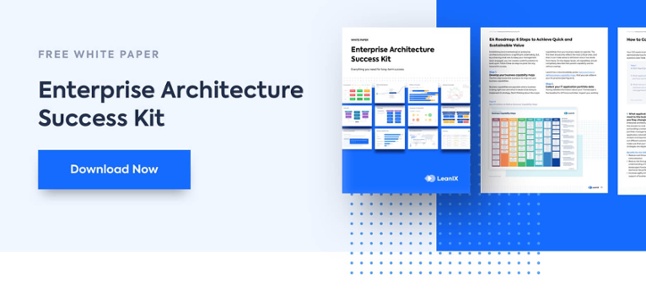What does Rome’s Colosseum, Paris’ Eiffel Tower, New York’s Empire State Building, and Spain’s La Sagrada Familia have in common?
They were all created by eminent architects.
Every structure that is built to last must have an architect or two paving the way. The architect drafts the blueprint elects the appropriate materials for the particular climate, anticipates the most optimal views, and supervises the entire project from beginning to end. The architect analyzes which new materials entering the market are fit for the project, decides which vendors to trust, and makes proper adjustments along the way.

You wouldn’t build a structure without an architect, would you? Well, don’t build an enterprise without one.
What does an Enterprise Architect do?
Enterprise Architects (EAs) link the business mission, strategy, and processes of an organization to its IT strategy. EAs document this linkage by using clear architectural models or views that show how the current and future needs of an organization will be met in an efficient, sustainable, agile, and adaptable manner.
EAs hold the key to analyzing the entire enterprise holistically. EAs are in the best position to sell the business potential of blockchain, IoT, artificial intelligence, and augmented reality.
Tech-savvy EAs see the possible profit streams from collecting and analyzing Big Data and will inform the CTO on which technologies or applications to focus on.
Sure, CIOs and CTOs are fully aware of these emerging trends, but only EAs have the specific purpose of aligning emerging IT trends, technology tools, and IT concerns with strategic business goals.
But, we already have a CTO!
Many organizations forgo hiring EAs because they wrongly assume that EA tasks are already completed by a CTO. Actually, CTO and EA are two starkly different roles. In smaller organizations, maybe the job titles merge, but its only because of coincidence or lack of knowledge.
The CTO is the chief technical strategist and many times the senior manager of the development and related organizations. Their focus is laterally within the senior management team and externally to the board and the industry. The EA’s focus is on each individual vertical within the organization.
One of the principal concerns of Enterprise Architecture is the lifecycle of the applications and what technologies are used by which one. At the same time, they ensure that the company as a whole has integrity and consistency.
What to look for in an EA?
So you’ve been convinced, and now you’re looking for an EA. Good luck. A recent KMPG study reports that big data, analytics, business analysis, and enterprise architecture are the most in-demand or fast-growing skills — yet six in ten respondents consistently report a technology skills shortage.
If you happen to find one out in the wild, be sure to see if he or she possesses the five integral traits to bring measurable value to your company.
1. Ability to execute
Progressive EAs assess which systems or processes are currently working and keep a sharp lookout for the imminent challenges and opportunities ahead. EAs of the future must quickly grasp, store, structure, and analyze information that could help solve an oncoming problem in the enterprise landscape. Not only propose and investigate possible resolutions but to continually remain helpful and accessible, offering supplemental support until a solution is reached.
2. Tech-savvy
The EA of the future must not only be aware of the availability of industry-relevant APIs, microservices, and emerging database technologies; but it is also imperative to exhaustively understand how a proposed service might improve or negatively impact the company.
3. Agile mindset
Agility has become a key characteristic of a top-performing EA of tomorrow. An important EA goal is to implement enterprise-wide agile methodologies to speed up software deployment timelines.
4. Data-driven decisions
All decisions that EAs of tomorrow make must be based on data. Data-driven decisions help leadership make the right investments and ensure the organization is working on the most impactful tasks to improve competitive advantage. High-performing EAs are on top of up-to-date analytics, prove hypotheses with data, regularly A/B test the practicality of current systems, and make decisions only from admissible data.
5. Evangelistic
Evangelistic EAs would pick one important topic that would greatly benefit the company whether it is microservices, DevOps, cloud migration, etc., and research, zealously advocating the particular cause. By thoroughly researching the technology, and the resulting ideation, evangelical EAs can provide internal teams and IT leaders with more than just a list of “cool” technology ideas.
Don’t sleep on Enterprise Architects.
In the era of rapid digital transformation, having an architect actively aware of all business trends on the horizon is key to staying competitive. An EA’s role is elaborate and extremely dynamic. EAs can deliver great value and cut cost and complexity by aligning IT concerns, technology tools, and strategic business goals. Remember the houses from above? Which type of structure will your enterprise build without an architect?
Enterprise Architects are the architects of a long-lasting company. Enterprise Architecture is a dynamic role that works just between the CTO and the dev team. As digital transformation is rapidly changing the business climate and enabling smaller startups to compete with a fraction of the capital, large enterprises would benefit from hiring an EA to keep the strategies aligned.

![Enterprise Architecture Success Kit [White Paper]: Everything you need for quick time-to-value and long-term success through EA. »](https://no-cache.hubspot.com/cta/default/2570476/17fd5630-69af-4c4c-82f1-8e88da49fc47.png)
![Re-Invent Your IT With a Lean Enterprise Architecture Framework [Poster]: Align Business and IT for Enterprise Architecture to succeed and achieve a simple, lean and structured overview! »](https://no-cache.hubspot.com/cta/default/2570476/7ea1b662-27e3-47a9-b92b-cc9462dd789e.png)



/EN/Reports/Thumbnail-Obsolescence-Gartner.png?width=140&height=100&name=Thumbnail-Obsolescence-Gartner.png)
/EN/White-Paper/EN-IDC-Inforbrief-Application-Rationalization-Portfolio-Management-Thumbnail_v2.png?width=140&height=99&name=EN-IDC-Inforbrief-Application-Rationalization-Portfolio-Management-Thumbnail_v2.png)
